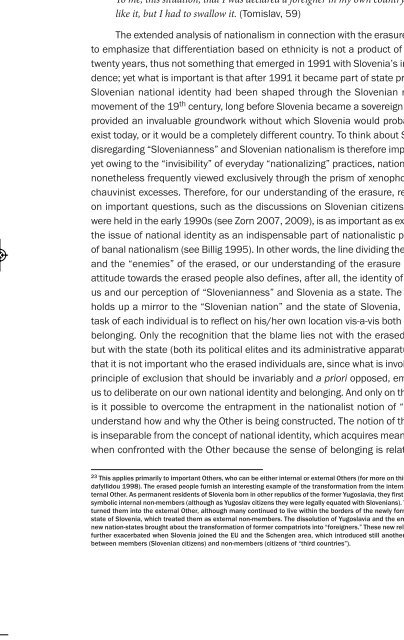The Scars of the Erasure_web
The Scars of the Erasure_web
The Scars of the Erasure_web
- No tags were found...
Create successful ePaper yourself
Turn your PDF publications into a flip-book with our unique Google optimized e-Paper software.
<strong>Erasure</strong>_4a 10.1.11 20:29 Page 205MORE THAN ADMINISTRATIVELY CREATED “FOREIGNERS”2054. <strong>The</strong> construction <strong>of</strong> national identity and <strong>the</strong> administrativeremoval <strong>of</strong> <strong>the</strong> O<strong>the</strong>rThat was when I started to, in order to adapt to <strong>the</strong> situation which I didn’t like.To me, this situation, that I was declared a foreigner in my own country, I didn’tlike it, but I had to swallow it. (Tomislav, 59)<strong>The</strong> extended analysis <strong>of</strong> nationalism in connection with <strong>the</strong> erasure servesto emphasize that differentiation based on ethnicity is not a product <strong>of</strong> <strong>the</strong> lasttwenty years, thus not something that emerged in 1991 with Slovenia’s indepen -dence; yet what is important is that after 1991 it became part <strong>of</strong> state practices.Slovenian national identity had been shaped through <strong>the</strong> Slovenian nationalmovement <strong>of</strong> <strong>the</strong> 19 th century, long before Slovenia became a sovereign state. Itprovided an invaluable groundwork without which Slovenia would probably notexist today, or it would be a completely different country. To think about Sloveniadisregarding “Slovenianness” and Slovenian nationalism is <strong>the</strong>refore impossible,yet owing to <strong>the</strong> “invisibility” <strong>of</strong> everyday “nationalizing” practices, nationalism isnone<strong>the</strong>less frequently viewed exclusively through <strong>the</strong> prism <strong>of</strong> xenophobic andchauvinist excesses. <strong>The</strong>refore, for our understanding <strong>of</strong> <strong>the</strong> erasure, reflectingon important questions, such as <strong>the</strong> discussions on Slovenian citizenship thatwere held in <strong>the</strong> early 1990s (see Zorn 2007, 2009), is as important as explaining<strong>the</strong> issue <strong>of</strong> national identity as an indispensable part <strong>of</strong> nationalistic practices<strong>of</strong> banal nationalism (see Billig 1995). In o<strong>the</strong>r words, <strong>the</strong> line dividing <strong>the</strong> “allies”and <strong>the</strong> “enemies” <strong>of</strong> <strong>the</strong> erased, or our understanding <strong>of</strong> <strong>the</strong> erasure and ourattitude towards <strong>the</strong> erased people also defines, after all, <strong>the</strong> identity <strong>of</strong> each <strong>of</strong>us and our perception <strong>of</strong> “Slovenianness” and Slovenia as a state. <strong>The</strong> erasureholds up a mirror to <strong>the</strong> “Slovenian nation” and <strong>the</strong> state <strong>of</strong> Slovenia, and <strong>the</strong>task <strong>of</strong> each individual is to reflect on his/her own location vis-a-vis both poles <strong>of</strong>belonging. Only <strong>the</strong> recognition that <strong>the</strong> blame lies not with <strong>the</strong> erased peoplebut with <strong>the</strong> state (both its political elites and its administrative apparatus), andthat it is not important who <strong>the</strong> erased individuals are, since what is involved is aprinciple <strong>of</strong> exclusion that should be invariably and a priori opposed, empowersus to deliberate on our own national identity and belonging. And only on this basisis it possible to overcome <strong>the</strong> entrapment in <strong>the</strong> nationalist notion <strong>of</strong> “us” andunderstand how and why <strong>the</strong> O<strong>the</strong>r is being constructed. <strong>The</strong> notion <strong>of</strong> <strong>the</strong> O<strong>the</strong>ris inseparable from <strong>the</strong> concept <strong>of</strong> national identity, which acquires meaning onlywhen confronted with <strong>the</strong> O<strong>the</strong>r because <strong>the</strong> sense <strong>of</strong> belonging is relative. 23 It23 This applies primarily to important O<strong>the</strong>rs, who can be ei<strong>the</strong>r internal or external O<strong>the</strong>rs (for more on this, see Triandafyllidou1998). <strong>The</strong> erased people furnish an interesting example <strong>of</strong> <strong>the</strong> transformation from <strong>the</strong> internal to <strong>the</strong> externalO<strong>the</strong>r. As permanent residents <strong>of</strong> Slovenia born in o<strong>the</strong>r republics <strong>of</strong> <strong>the</strong> former Yugoslavia, <strong>the</strong>y first constitutedsymbolic internal non-members (although as Yugoslav citizens <strong>the</strong>y were legally equated with Slovenians). <strong>The</strong> erasureturned <strong>the</strong>m into <strong>the</strong> external O<strong>the</strong>r, although many continued to live within <strong>the</strong> borders <strong>of</strong> <strong>the</strong> newly formed nationstate<strong>of</strong> Slovenia, which treated <strong>the</strong>m as external non-members. <strong>The</strong> dissolution <strong>of</strong> Yugoslavia and <strong>the</strong> emergence <strong>of</strong>new nation-states brought about <strong>the</strong> transformation <strong>of</strong> former compatriots into “foreigners.” <strong>The</strong>se new relations werefur<strong>the</strong>r exacerbated when Slovenia joined <strong>the</strong> EU and <strong>the</strong> Schengen area, which introduced still ano<strong>the</strong>r distinctionbetween members (Slovenian citizens) and non-members (citizens <strong>of</strong> “third countries”).


